Two years ago, war broke out in Ukraine. As its citizens fled, many animals were left behind. But they were not abandoned completely.

Inside a dimly lit room at Poznań Zoo, Poland, two men pry open a makeshift wooden crate. As the lid pops, a tiger cub springs out, all claws and fangs. It has endured a three-day transit by truck with no food or water and is starving and stressed.
The cub has not arrived at the zoo alone; various other containers are still in a truck outside. While their occupants await release, staff use tweezers to pass small items of food through roughly drilled breathing holes and between bars.
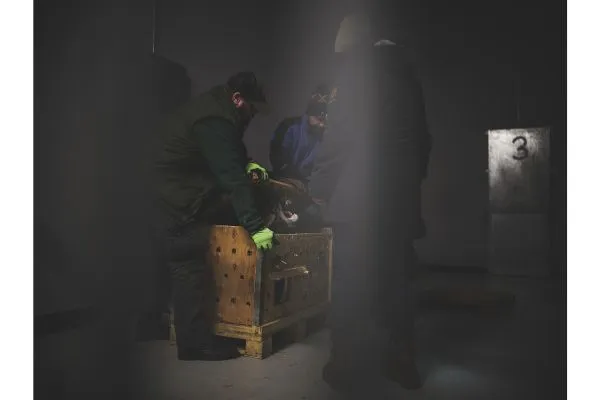
It’s 3rd March 2022, day seven of Russia’s invasion of Ukraine. Being unboxed before me is an extraordinary menagerie of animals: six tigers, four lions, two caracals, an African wild dog, a capuchin and even a stray cat. All have been rescued from war-torn Kyiv and brought to the safety of Poznań Zoo.
The last individual to be released is Kaja, a 16-year-old circus tigress. She is gently carried into an enclosure and laid on some hay. Blind and declawed, she starts slowly licking and gnawing her paws, quietly vocalising. I feel a heaviness in the pit of my stomach, but that Kaja has even made it to Poznań alive is nothing short of remarkable.
Several days earlier, while working at the Poland-Ukraine border as a fixer, assisting other journalists in the field, I had heard a rumour that a number of big cats were heading our way, evacuees from Kyiv Zoo that were being transported to Poland. But these were not zoo animals. They were individuals from private collections, acquired via a black-market trade in exotic pets that is rife in Ukraine, and left behind as their owners fled the war.
The Russian invasion of Ukraine is a human tragedy, but also an animal tragedy. Thousands of animals – pets and livestock, but also those housed in zoos, private houses, circuses, shelters and vet clinics across the country, have been caught up in the conflict, forcefully separated from their owners or simply abandoned. Yet a great effort is being carried out by people across the country to save them.
Playing a major role in this operation are two incredibly determined women who have teamed up across the Poland-Ukraine border. On the Polish side is Ewa Zgrabczyńska, director of Poznań Zoo and renowned for combatting the illegal trafficking of big cats through the country. It is at her insistence that the zoo is providing sanctuary for the evacuees until they can be rehomed elsewhere.

On the Ukranian side is Nataliia Popova, a former equestrian champion. She rescues animals stranded at the front line – often alone, and often risking her life to do so. Her horse-riding centre, Magnat, on the outskirts of Kyiv, now functions as an emergency vet clinic, providing first-aid to everything from bears to birds while they await transit to Poznań Zoo.

I follow Ewa to her office, where she attempts to soothe the capuchin. The walls are adorned with children’s drawings; the floor and furniture bear the scrapes and scars of the many creatures that have taken refuge here. “We don’t know if these animals will survive,” she says. “But we’ll do our best for them and for Nataliia.”
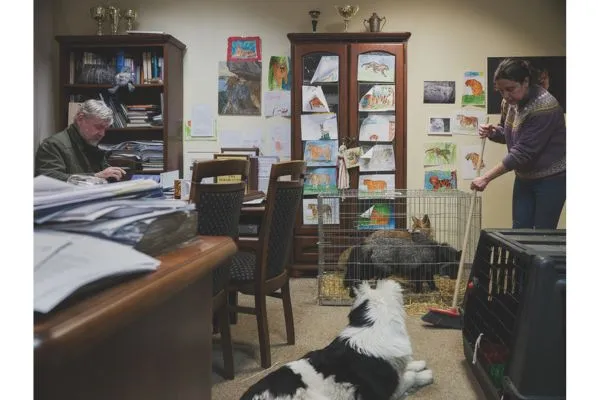
Two weeks later, I meet volunteer drivers Olena and Ivan from animal welfare organisation UAnimals, who have started to assist Nataliia with rescue operations. We’re on the Ukrainian side of the Korczowa-Krakovets border. They arrive in an animal ambulance complete with two lions, two tigers, several Arctic foxes (from a fur farm), plus a cohort of pet raccoons and domestic cats. The animals are unloaded from their vehicle and reloaded into our Polish one, against a chaotic backdrop of fleeing refugees, busy aid workers and volunteers arriving to fight. The border guards take selfies with the animals and Ivan jokes that if he opens the cages they will create a green corridor here. As we drive our charges across into Poland, one of the lions roars so powerfully that I can feel the vibrations passing through the chassis.
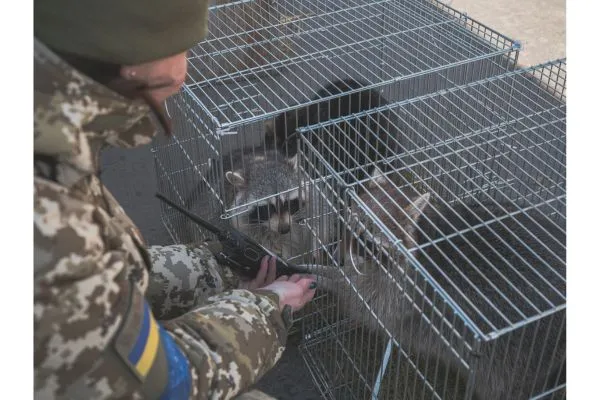
A few days later, I’m back in Ukraine with Olena and Ivan on a supply run to Magnat. The goods we are carrying are courtesy of Ewa. Knowing that Kyiv could be surrounded in days, she has packed up as many food items, supplements, tranquilisers and sedatives as she can. A curfew is in place as Ukrainian forces launch a counter-offensive to push the Russians out of the capital. “The mayor of Boryspil has called for all citizens to leave,” says Olena, reading the news out loud. Magnat is very close to Boryspil, on the outskirts of Kyiv, but we know that Nataliia won’t desert her animals.
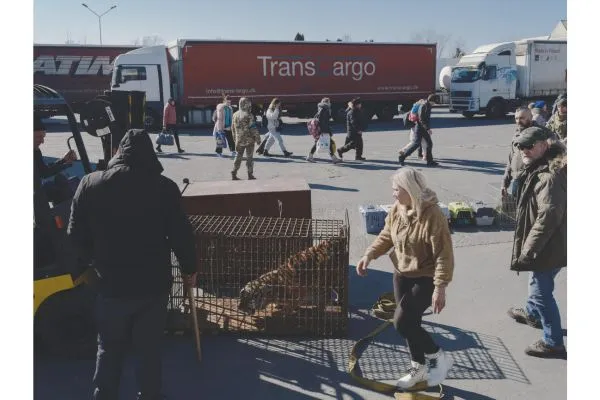
Ivan crosses himself and lights a cigarette. “Don’t fasten your seatbelt,” he warns. “Watch me closely. If I go down, you go down.” He accelerates and manoeuvres between lorries, taking us through the town of Vinnitsa.
Though we are some distance from the front line, Ivan sees smoke and enquires on the radio about recent shelling. It seems a garrison or ammunitions stock has been hit. We take the long way round, avoiding the towns of Hostomel and Bucha, where heavy fighting has broken out. “Google Maps doesn’t tell you where the Chechnyans are,” jokes Ivan.
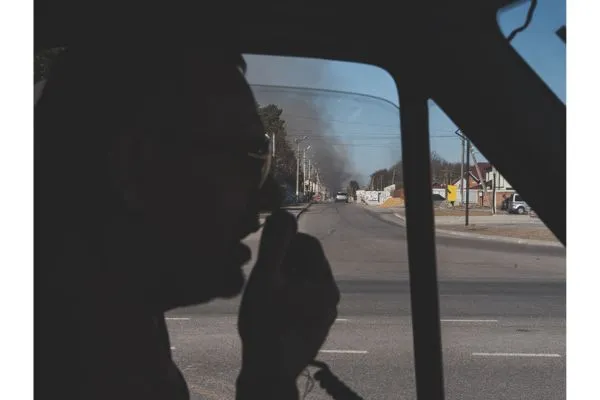
Olena mentions that there’s a lion called Ruru in Hostomel that needs evacuating. She is met with silence. We take the Kyiv ring road, which leads us closer to the front line. “You see that smoke? That’s around Kyiv,” says Ivan. Olena helps to transfer the animal evacuees at the Korczowa border.
In the background, citizens are also escaping the conflict. I notice he is paying close attention to the sky, scanning for aircraft flying low to avoid detection. At every military post on the empty highway, Ivan exchanges greetings in the form of a clenched fist: “Glory to Ukraine! Glory to the heroes!”.
The travel information usually displayed on the digital road signs has been replaced with a single, unfriendly message to the Russians. We arrive at Magnat in a blackout, our headlights off. The battle front is just 8km away in Brovary. As we turn onto the gravel road, the silhouettes of vehicles and soldiers catch in the indicator lights.
We are greeted by Nataliia; Sveta, the centre’s former restaurant manager; and Sofija, Sveta’s 14-year-old daughter. Like Nataliia, both refuse to leave. The noise of artillery fire rumbles in the distance, but tonight, the skies over Magnat are clear. We stay outside a while, admiring the stars.
Taking me around the centre, Nataliia explains how it all began. In 2018, when she was running Magnat as an equestrian centre, she had a call from a welfare organisation that needed help saving a lioness called Yana. “I could see from a photo how miserable she was – nobody wanted her, so I took her,” Nataliia recalls.
Soon, Magnat was doubling up as an animal rescue centre, taking everything from tigers to parrots to reptiles.
She set up a funding webpage, but only received more pleas for aid. Can you help this suffering bear? Can you take in this tiger? “And I couldn’t say no,” she says. Soon, Magnat was doubling up as an animal rescue centre, taking everything from tigers to parrots to reptiles.
“Yana! Come here,” she calls, warning me to keep my distance. We’re still in darkness, and I can just make out the shape of a lioness rubbing herself against bars. “Humans have abused her – she’s been beaten and electrocuted,” says Nataliia. “She doesn’t like people now. She has a broken spine; she can walk a little, but evacuation to Poland is not an option. She will stay with us.”
It’s still the early days of the war, but Natallia has already taken in hundreds of animals. The first was a lion from Kramatorsk. “She had no food and water and was dying, but nobody could reach her due to the shelling,” says Nataliia. “Can you imagine what a frightful death that would be? I went to get her, I was scared – everyone was scared – but I went anyway. Everyone has to do what they can in this war. I save animals, if the missiles don’t get them first.”
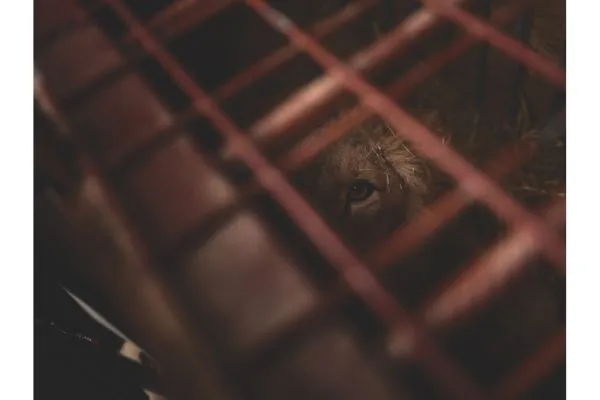
Transporting animals across borders is complicated at the best of times; during a war it is beyond dangerous. Those whose welcome I witnessed at Poznań Zoo had been lucky to even leave Magnat, loaded onto trucks just as Russian forces were advancing on Kyiv.
“The TDF (Territorial Defence Forces) had called that night to warn me that a Russian convoy was nearby,” recalls Nataliia. “I saw them by my fence – the TDF asked me what I saw exactly, but I didn’t go out to check. I was petrified.” The Russians didn’t spot Nataliia or the other volunteers hidden within the centre, nor did the TDF engage – at Nataliia’s request. An exchange of fire would almost certainly have proved fatal for the animal evacuees, packed up inside trucks parked across the centre’s entrance.
Only once the Russians had moved on could the convoy depart, managing to circumnavigate the shelling and troops to reach the border. We head to the restaurant to join the others. The windows are blacked out with drapes and we eat by candlelight. Nataliia, Ivan and Olena discuss options for the rescue of Ruru the lion in Hostomel.
“I’m not a zoo,” says Nataliia. “My goal is to save and stabilise, then send animals to a better place.”
In the morning, we unload the supplies from Ewa and I see Magnat in the daylight. Various enclosures, stables and makeshift aviaries are scattered across a facility long past its prime. “I’m not a zoo,” says Nataliia. “My goal is to save and stabilise, then send animals to a better place.” She points to a pen. “There, we had circus bears. I had to take them or they would have been put down. They are now in Romania.”
Veterinary support will come further down the line, but for now, Nataliia has to be self-sufficient. She has taught herself to assess an animal’s condition and administer medicine. Crucially, she’s also learned how to anaesthetise animals when working alone.
It’s time to head back to Poland. We were hoping to take another transit of animals with us, but it is stuck behind the Russian line. Olena and Ivan decide that we will go via an animal hospital west of Brovary, where hundreds of cats are stranded. They manage to rescue 40, and I take one more, making it a collar from a press band. As opposed to a lion’s roar, from the back of the truck now comes a clamour of muffled, scared mewing.
A few days later, Ukrainian troops force the Russians to retreat, liberating the towns of Irpin, Bucha and Hostomel. Nataliia, Olena and Ivan work tirelessly to rescue any animals that are stranded on these former battlegrounds. Ruru is among their number.
As with any story of war, the picture is bleak. None of these animals have a bright future, and the majority can never be reintroduced to the wild. Nonetheless, they will at least be afforded a better quality of life away from the conflict, thanks to the people that have chosen to protect them.
Their courage and determination to save a nation of animals is awe-inspiring.
With the war unlikely to end any time soon, Nataliia, Ivan, Olena and many other animal-aid volunteers across Ukraine, as well as Ewa in Poland, continue to burn the candle at both ends. Their courage and determination to save a nation of animals is awe-inspiring. Not only are they giving these creatures sanctuary away from the conflict, but their efforts may in time help to fight the illegal trade in exotic pets in Ukraine. As combat continues, so their endeavour continues, to save the animals of war.
What happened next?
- Kaja the lion lived for another year at Poznań Zoo, being cared for amongst other tigers before finally passing away in May 2023.
- Ruru the lion was successfully evacuated to Poland. In July 2022, he was moved to a sanctuary in Spain.
- All six tiger cubs from the first transit are still at Poznań Zoo.
- The caracals from the first transit went first to Belgium, and are now in the UK.
- Yana the lion passed away a few months after the invasion. She had been cared for by Nataliia for four years.
About the author
Michal Siarek is a documentary photographer based in northern Norway. See more of his work on instagram.
Find out more
Read about other inspiring animal rescues, including Mauritian reptiles escaping an oil spill and a dramatic rescue mission for rare frogs in Chile.